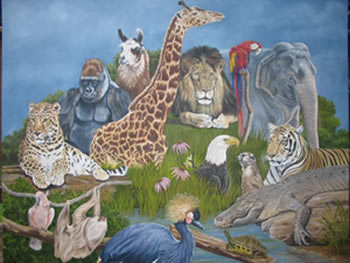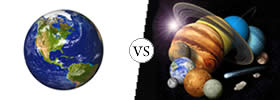Difference between Animal and Human
Key difference: Humans are basically animals, who differ in various contexts from other animals. One of such drastically considered context is the intellectual system, that is humans have a well developed brain (intelligent system) than animals.
The word “animal” originated from the Latin word animalis, meaning “having breath”. They belong to the kingdom Animalia. Biologically, they include all the members of kingdom Animalia, encompassing creatures as diverse as sponges, jellyfish, insects, and humans. They are multi-cellular, eukaryotic organisms of the kingdom Animalia or Metazoa. Animals are living organisms, which feeds on any organic matter typically having the nervous systems, sense organs and responsiveness to the stimuli. Their scientific study is known as Ethology.
 Animals are terrestrial, aquatic, aerial and amphibious. They are basically subdivided into groups such as of carnivores, herbivores, omnivores, and parasites. They include various categories, which comprises of microbes, insects, birds, reptiles, fish, and mammals, including humans. They consist of a wide spectrum of species including different classes, phylum and types.
Animals are terrestrial, aquatic, aerial and amphibious. They are basically subdivided into groups such as of carnivores, herbivores, omnivores, and parasites. They include various categories, which comprises of microbes, insects, birds, reptiles, fish, and mammals, including humans. They consist of a wide spectrum of species including different classes, phylum and types.
Animals have body structures, which are eventually fixed and developed by undergoing the process of metamorphosis. They are motile, which means, having the ability to move spontaneously and independently. They have numerous characteristics which distinguishes them from the living-beings:
Animal structure also ranges from the tissue type of sponges (Phylum Porifera) and placozoa, till the fully grown matured muscles and nervous system of humans. Their formation includes many chemicals comprising of hormones, proteins, genes, bones, etc., and obtain the energy from the source of food. Food provides them with all the essential and nutritive components, which are necessary for growth. Their type of food depends on their type of subgroups. They reproduce sexually as well as asexually. Almost all animals undergo sexual form of reproduction. These have a few specialized reproductive cells, which undergo meiosis to produce smaller, motile spermatozoa or larger, non-motile ova, which further fuse to form zygotes that develop into a new individual. Many animals also reproduce asexually. These include parthenogenesis, where fertile eggs are produced without mating, budding, or fragmentation.
In common usage of the word, “human” generally refers to the only extant species of the genus Homo (anatomically and behaviorally modern Homo sapiens). The term also designates the collective identity, often applied to superseding concepts of race and creed; e.g. “our” human nature and humanity.

Humans are primates of the family Hominidae, and the only extant species of the genus Homo, which falls under the Animal Kingdom. Their lineage diverged from the last common ancestor with its closest living relative, the chimpanzee, around some five million years ago, evolving into the australopithecines and eventually the genus Homo. The first Homo species, who moved out of Africa, was Homo erectus (the African variety), along with Homo heidelbergensis, who are considered to be the immediate ancestor of modern humans. Homo sapiens originated in Africa, acquired the anatomical modernity about 200,000 years ago and exhibited the full behavioral modernity around 50,000 years ago. Homo sapiens then proceeded to many other parts of the world.

Humans are distinguished from other primates by their bipedal locomotion, and their relatively specialized larger brain. They have a particularly well developed neo-cortex, prefrontal cortex and temporal lobes, which enables the high levels of abstract reasoning, language, problem solving, and culture through social learning. They are uniquely adept at utilizing systems of symbolic communication such as languages and arts for self-expression. They have the ability to exchange ideas, and organize them in a well-oriented manner. Their social interactions have established an extremely wide variety of values, social norms, and rituals, which together form the basis of the human society.
 Humans create complex social structures composed of many cooperating and competing groups, from families and kinship networks to states. They use tools to a much higher degree than any other animal. They are considered to be the ‘only extant species’. They are known to build fires and cook food, provide clothing for themselves, along with the creation and use of various technologies and arts. Their scientific study is known as the discipline of Anthropology. The invention of the locomotive stone wheel was one of the more significant inventions that cumulated in the Paleolithic Age; afterwards they developed their livelihood by practicing agriculture and animal husbandry living in caves. They started living in groups and formed families, which was the formation of the beginning of society. They are considered to be the developed form of the animal species. They have an erect body posture, with an extra-intellectual developed brain. They reproduce sexually, and are mammals. They form the most-integral part of the world and are responsible for bringing the wide change and development in the society.
Humans create complex social structures composed of many cooperating and competing groups, from families and kinship networks to states. They use tools to a much higher degree than any other animal. They are considered to be the ‘only extant species’. They are known to build fires and cook food, provide clothing for themselves, along with the creation and use of various technologies and arts. Their scientific study is known as the discipline of Anthropology. The invention of the locomotive stone wheel was one of the more significant inventions that cumulated in the Paleolithic Age; afterwards they developed their livelihood by practicing agriculture and animal husbandry living in caves. They started living in groups and formed families, which was the formation of the beginning of society. They are considered to be the developed form of the animal species. They have an erect body posture, with an extra-intellectual developed brain. They reproduce sexually, and are mammals. They form the most-integral part of the world and are responsible for bringing the wide change and development in the society.
Comparison between Animals and Humans:
|
|
Animals |
Humans |
|
Oxford Dictionary Definitions |
Animals are: “a living organism which feeds on organic matter, typically having specialized sense organs and nervous system and able to respond rapidly to stimuli”. |
Humans are: “relating to or characteristic of humankind”. |
|
Origin in the world |
Their origin was the formation of the living world. |
They originated from the chimpanzee and began the society in the world. |
|
Kingdom |
They belong to kingdom Animalia or Metazoa . |
They belong to kingdom Animalia. |
|
Scientific study known as |
Their scientic study is known as Ethology. |
Their scientific study is known as Anthropology. |
|
Intellectuality |
They lack an intellectual brain, as compared to humans. |
They are known due to their intellectual brain. |
|
Categories |
They consist of oviparous as well as viviparous categories of animals. |
They are basically viviparous. |
|
Appearance and features |
They possess an ancient physical appearance and brain. |
They have a developed physical appearance along with the developing mind. |
|
Commonly are |
They are vertebrates and invertebrates. |
They are purely vertebrates. |
|
Reproduction |
They reproduce sexually as well as asexually. |
They reproduce only sexually. |
|
Socially they are |
They do not comprise of social living. |
They are the creaters of society. |
|
Importance |
They mark the existence of the living world along with the nature. |
They are the craters and inventors of research and technologies. |
Image Courtesy: karenkingdesign.com, sciencebasedlife.wordpress.com, indiatimes.com, jobstatitlek.silkroad.com









Add new comment